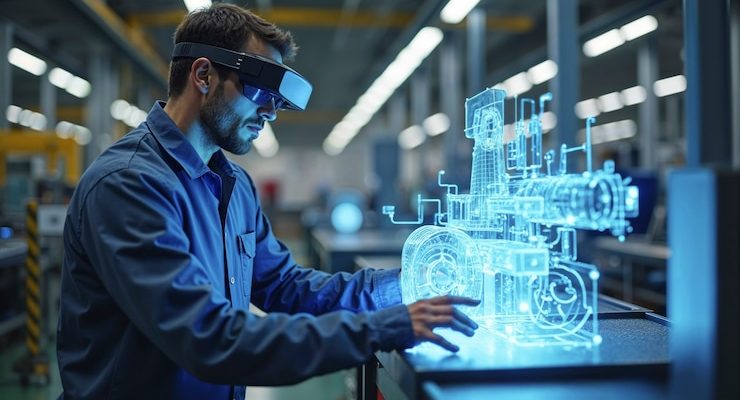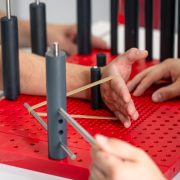As the industrial landscape continues to shift at a rapid pace, precision, safety, and efficiency are critical. It is important to gather highly accurate information when designing a new facility, upgrading existing systems, or doing maintenance work in a plant that is still operating.
This is where plant scanning services using 3D laser scanning will become relevant. Not only do new technologies like the use of 3D laser scanning provide a new dimension to the way in which engineers and project managers think about the design of industrial plant systems.
In this blog post, we will delve into the concept of 3D laser scanning for industrial plant design, looking at its uses, benefits, how it works, and the increasing need for plant scanning services in the modern industrial ecosystem.
What is 3D Laser Scanning?
3D laser scanning is a non-contact, high-speed, high-accuracy way of capturing objects/environments in the real world as dense point clouds. The Use of 3D Laser Scanning Technology is such that the scanner uses laser beams to detect surfaces through a process of bouncing the laser beam off a surface, returning data about distance, angle, and geometry to create a highly accurate representation of scanned objects. A 3D model of the scanned object or environment may be generated from this data.
Why is 3D Laser Scanning Essential in Industrial Plant Design?
Industrial plants tend to be complicated environments that operate 24 hours a day with safety, layout, and operations in mind.
- Depending on the intended scope of work, changes in the facility from the original (or most recent) assessment are valuable when considering facility expansions, retrofits, or maintenance work.
- Manual measurements are time-consuming, often contain human error, anare d particularly difficult in hazardous and/or congested areas.
This is where use of 3D laser scanning has its greatest value. It captures the entire environment accurately in a safe and timely manner at millimetre-level precision for effectively planning, designing, and documenting plant layouts.
How Plant Scanning Services Work?
The process of working of plant scanning services is in various steps;
- Site Survey
Technician teams travel to the site with 3D laser scanners and establish multiple scan stations throughout the plant.
- Scanning Process
The scanner will emit millions of laser points per second to capture the geometry, layout, and dimensions of the physical assets located in the plant- pipes, tanks, columns, ducts, and machinery.
- Point Cloud
Data from various scan positions are merged into one comprehensive point cloud — essentially, a digital twin of the plant’s environment.
- Modeling & Conversion
Point clouds, once captured, can be modelled or converted into usable form (e.g., 3D CAD model or BIM model) that can be used by engineers/Designers to plan layouts, not to mention can be used in clash detection.
- Integration with Software
The model is easily integrated into plant design software like AutoCAD, Revit, PM, or AVEVA, and can be easily integrated into the workflow.
Key Applications of Plant Scanning Services
- As-Built Documentation
3D laser scanning captures every existing detail of the plant and enables the engineers to keep the as-built documentation current since drawings may be unavailable, inaccurate, or many years old. - Plant Expansion & Retrofit Planning
A designer must know existing constraints before upgrading the plant. With the plant scanning services providing an exact digital twin, the designer can plan the new installation so that the new installation will not interfere with any of the previous installations. - Clash Detection
The designers, with the aid of the scanned environment, can visualize the new design module against the scanned reality. Identifying potential interferences early will save time, money, a nd rework on-site. - Structural Integrity Assessment
With frequent periodical scans and comparisons, engineers may quantify the change in deformation or movement in critical areas to perform predictive maintenance and identify potentially dangerous locations. - Create Digital Twin
With accurate 3D models, companies can create digital twins, which are real-time digital replicas of their plant environments, that can be used for monitoring, simulation, and remote inspection.
Benefits of Using 3D Laser Scanning in Plant Design
- High Precision: You can achieve millimeter accuracy which this is particularly important for complicated environments such as processing plants, where access to every inch is required.
- Time Savings: Plant scanning services can allow you to achieve what would take weeks using manual methods in hours, which reduces downtime and improves project lag time.
- Improved Safety: 3D laser scanning reduces exposure to physical hazardous zones, which enhances technician safety while performing the survey faze.
- Cost Savings: One might even think that such a tool as 3D laser scanning is a very expensive technology, but in fact, it will save an organization a fortune, eliminating costly mistakes, redesigns, and putting programs on hold.
- Full-detail Visualisation: Engineers can work off of highly detailed 3D models, which increases collaboration, comprehension, and speeds up decisions.
Real-World Case: Optimizing a Chemical Plant Layout
A global chemical manufacturer required a retrofit of part of its plant to install distillation equipment. The existing drawings were outdated, and the usable space was limited, which would introduce or increase design risk.
- The chemical manufacturer employed a plant scanning service and received an accurate 3D model of the area scanned.
- Engineers then used the 3D models to virtually simulate several layout options, questioned if the spatial conflicts could be resolved, and completed the installation with zero rework.
The outcome? The chemical manufacturer finished the project 30% quicker, and the cost for installation savings was approximately 18%.
Integration with BIM and Industry 4.0
Use of 3D Laser Scanning has a role to play in Building Information Modeling (BIM), which is being widely adopted in the way we execute industrial projects. With BIM, data from the scan can be overlaid with additional project data, such as materials, maintenance data, asset IDs, etc, to create a single source data environment.
Both IoT, AI and remote monitored trends of Industry 4.0 are enabling these 3D models to be the basis of smart plant operation, predictive maintenance, and virtual training environments.
Future of Plant Scanning Services
The future of plant scanning services is not just based on better data acquisition; it is about providing smarter, quicker, and more connected environments for industry.
Rapid advancements in laser technology, AI integration, and speed of real-time data processing are enabling 3D laser scanning to be used in ways that were previously unimaginable, in just helping with the design process.
Project teams will no longer need to wait to receive project site data; they will be able to get live site data in seconds.
This will speed collaboration and cut project timelines from months to weeks.
Fibrox3D specializes in delivering high-accuracy plant scanning services to industrial environments in the manufacturing, oil & gas, chemicals, and pharmaceuticals sectors.
Conclusion
3D laser scanning has transformed industrial plant design to provide unmatched accuracy, efficiency, and safety. With new plant scanning services available, businesses can now “futureproof” their plant, ensure easy integration of new systems, and save money and time.
As more industries move into digitization and smart manufacturing, laser scanning is one of the necessary technologies on the path to smarter, safer, and more productive plants.
Want to enhance your plant design with futuristic technology? Choose Fibrox3D – reliable, proven plant scanning services. Visit us at Fibrox3D.com and redefine plant design with 3D laser scanners!
Also Read: Drone Mapping Services Explained: Benefits, Applications & Costs















Comments